VooXdoo Yachts new XF60.
Power catamarans are becoming an increasingly prominent part of the boating scene. Despite this relative familiarity there is still a perception that all catamarans are the same. It is obviously not true that all monohulls are the same, so why should it be true for catamarans? Just as for monohulled vessels, there are numerous sorts of power catamaran.
Which one is used should depend on the purpose for which it is intended. And, just like monohulls, you need to have the right boat for the job. However, unlike the monohulled vessel, there is a much greater overlap in performance and behaviour between the two basic types, the planning craft and the displacement vessel. This is largely because a displacement catamaran can, unlike its monohulled cousin, often go just as fast as a planning one, and in some sea state conditions, faster. However, it is not quite that simple. There are many more variables than just the hull form. So, let’s look at some of the parameters that differentiate the different types of catamaran and see if we can determine how they may affect your choice.
Although the hull form is not the only variable to a lot of people it is certainly one of the most obvious. If we ignore the more exotic examples of the breed, such as the SES [surface effect ships/side wall hovercraft] craft and the SWATH [small water plane area – twin hull] which is really a very extreme displacement vessel, then there are two basic types; the planning hull and the displacement hull.
The hull of a planning catamaran is similar in shape to that of a planning monohull. It is generally a relatively low deadrise hard chine hull with no rocker. Just like a monohull, it may have planning strakes and the currently very fashionable steps. There are planning catamaran hulls in which the deadrise angle is constant for at least the aft half of the hull (monohedron hulls) and others where it will vary along the length (warped plane hulls). Others may be similar in section to the deep vee monohull. There are also a number of variations on the single chine/multiple chine/longitudinal step (strakes), theme.

However, there is one planning catamaran hull form that you will be very unlikely to see on a monohull.
This is the asymmetrical planning hull as epitomised by many of the designs of Scott Robson, as far back as in the 1980. Today Robson continues to develop new hybrid designs utilising the best concepts from both asymmetrical and symmetrical hull forms. This means that the inside of the hulls is flat with all the shape on the outboard side.
This configuration is considered to have superior performance to the symmetrical shape in some conditions and is particularly suitable for fitting hydrofoils. It can also be designed to lean into a turn just like a monohull, whereas the symmetrical-hulled planning cat will tend to lean outward in a turn. Displacement cats also lean outward in a turn but because the angle of heel is around half a degree it is usually not even noticed. Planning power cats, are essentially two narrow planing monohulls placed side by side with a bridge deck in between. Nic De Waal of Teknicraft uses planning hulls that are symmetrical forward but asymmetrical down aft.
Robson amd Hill throw an extra wrinkle into the mix by fitting foils to their boats that are going to exceed 30 knots. Foils allow the boats to plane sooner and also carry heavier loads when on the plane. The retrofitting of foils is sometimes used to enable a planning cat that is showing a disinclination to plane, to do so.
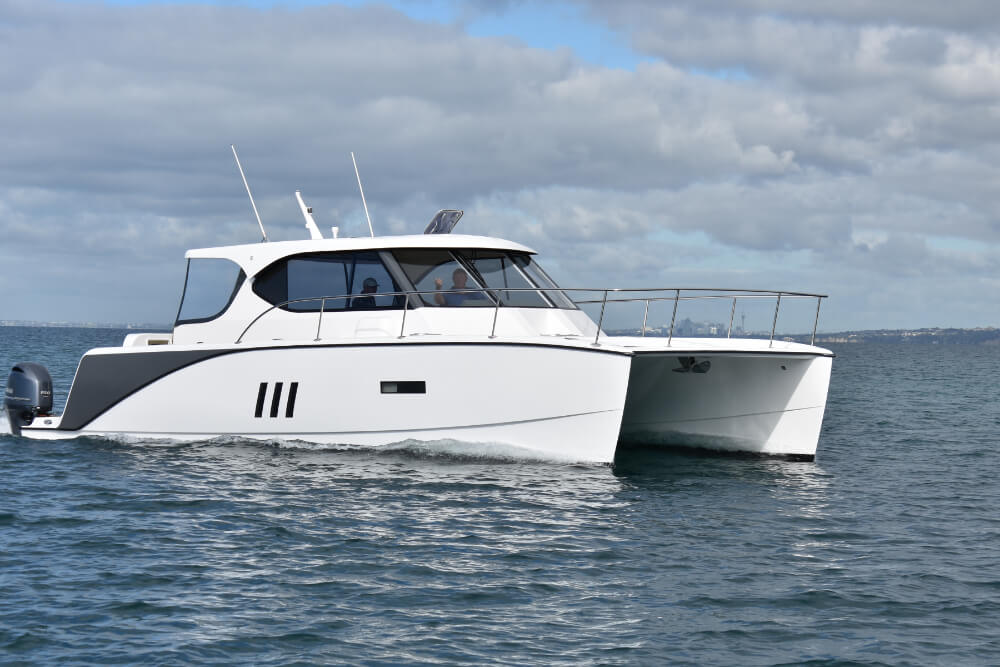
The fitting of foils is an approach that is difficult to use on a monohull but the catamaran configuration is perfectly suited to them as the main load-carrying foil is generally fitted between the hulls. Foils, particularly the active systems, are also sometimes fitted to the larger displacement hull forms, such as those found on high speed ferries, to improve the ride quality. The new generation of Voodoo high speed power cats are all fitted with foils.
Robson says the rule of thumb if you want to go over 45 knots is you need a foil. Under that speed you can get away without one. Hill agrees, if you want to achieve high speeds, in excess of 35-40 knots in a big cat you need to have foils and Hill has certainly proven to be a master at marrying foils to big cats. His latest project, the 20m Carbon Cat being built by Scott Lane Boatbuilders is designed to achieve around 45 knots, a speed that would not be attainable without the use of foils.
However, Robson also says he often puts foils on boats achieving 25-30 knots as it enhances the ride and performance of the boat.
PLANING HULL
Generally, the planing cat is designed for relatively flat water, but it will still handle rougher conditions better than a monohull, provided there is sufficient wing deck clearance. It is also usually a relatively short-range vessel and is also relatively small. Just like a monohull, it becomes increasingly difficult to make the vessel plane as it gets larger. This is largely because while the planning area is increasing by the square the displacement is increasing by the cube.
It just requires more and more horsepower to plane and at somewhere around 18 to 20m it makes more sense to go to a displacement hull form which at this particular size will go just as fast, if not faster, with considerably less horsepower. Works well if a boat has a top speed up to around 26 knots.
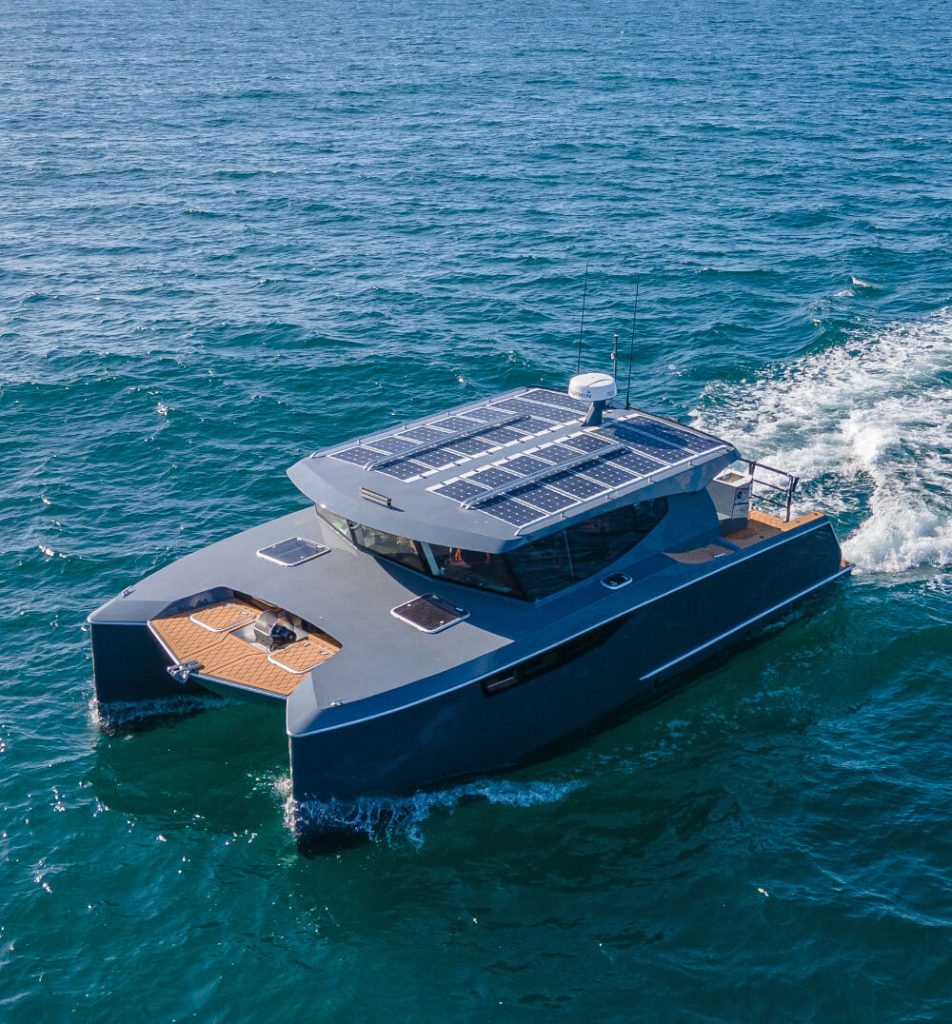
Just as with monohulls, it is expensive to run a large, fast, planning vessel. However, the converse size wise is also true. It becomes increasingly difficult to justify the use of the displacement hull forms below about 10 m in length unless you are willing to go quite slow or have hulls that can only be used for stowage. Essentially, if you want to go fast in a “short” catamaran you use a planning hull form.
DISPLACEMENT HULL FORM
So, what characterises the displacement hull form? It is usually a round bilge form of minimum wetted surface that depends on its length, plus the hull water line length to hull water line beam ratio, to achieve high speeds. Unlike the monohulled displacement craft, the hull speed (in knots) of the displacement catamaran is not restricted by the familiar 1.34 times the square root of the waterline length (in feet), of Froude’s Law.
Like the planing hull cats, there are a number of different design approaches to the shape of the displacement hulls. Many of the French catamaran companies just fit larger engines into their sailing hulls, probably because they have the moulds handy. This is fine as long as you are not going to exceed around 15 to 18 knots. Beyond this speed the hulls start squatting and assuming a bow-up attitude. They are essentially trying to go up-hill and require increasingly large amounts of horsepower to move.
Alan Wright, and a number of other designers, takes a somewhat different approach. He took the traditional trawler displacement hull, made it much narrower so it had a higher hull speed and then joined two of them together with a wing deck.
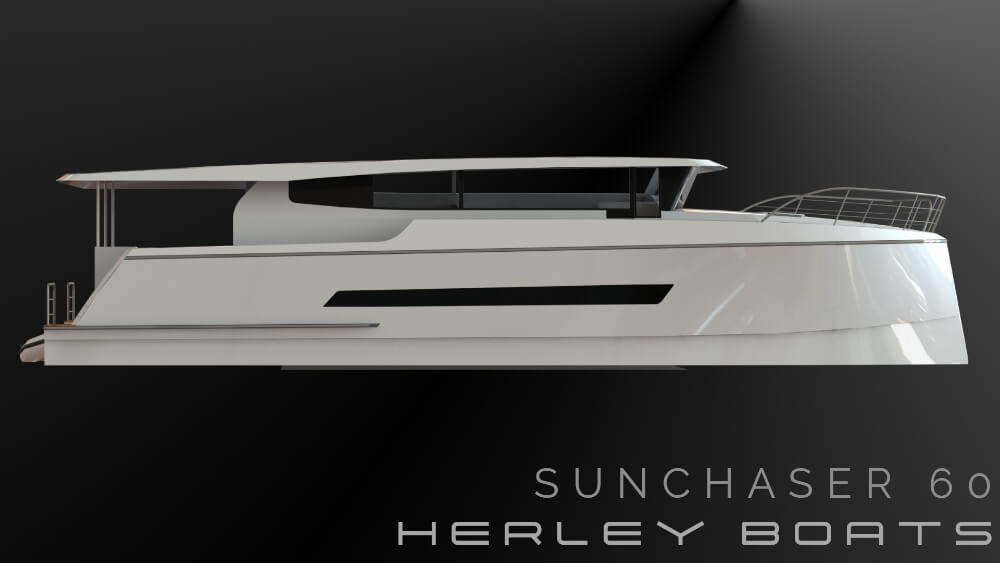
When in 1983 the writer’s design office staff started looking at power catamaran design, they used the sailing cat hull shape because they knew how fast they could make them go from many years’ experience of designing sailing catamarans. However, to prevent the squatting normally associated with this hull form, they increased the buoyancy down aft by fitting a bustle with a vertical trailing edge. This proved to be a difficult hull shape to construct as a one-off and so the buttock lines were straightened and, instead of kicking the hull lines up toward the surface down aft, as with the traditional displacement hull shape, they drew them in to form a canoe stern. They then placed a large amount of buoyancy above this in the form of a flat section to prevent squatting.
Since then this form has been refined by the addition of a concave surface above the propeller complete with some kick down toward the aft end. The distribution of the buoyancy has changed slightly, and the entry has been fined up even further. Now that this particular form that they developed has proven to be so successful it has become the preferred shape for an increasing number of displacement catamaran designers world-wide.
BULBOUS BOWS
It is not unusual to see a displacement hull with a bulbous bow and there are several reasons why a designer might employ such a device. One of the parameters that determine the resistance of a displacement hull is the hull’s half-entry angle. The finer the entry, the lower the resistance. By its very nature, any catamaran hull is finer in the forward sections than an equivalent monohull and this tendency is more exaggerated in the low-resistance displacement hull. As a consequence of this, the longitudinal centre of buoyancy (LCB) of such a hull tends to be located well aft. If the superstructure of such a vessel is then located well forward, it will be necessary to fit a bulb to move the LCB forward to where the LCG is located, if a bow-down trim is to be avoided.
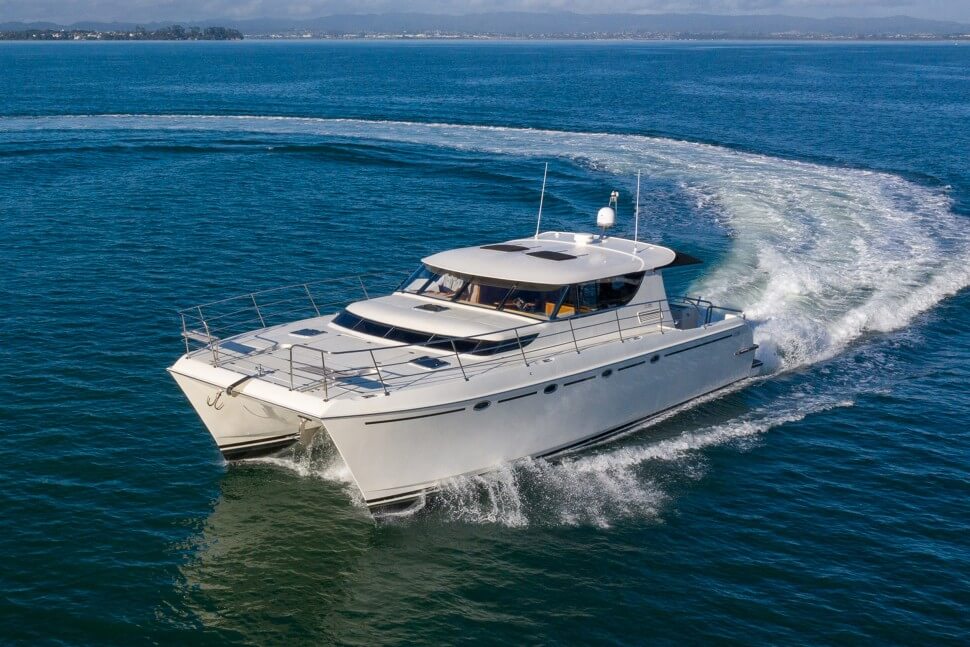
This characteristic is clearly illustrated by the fine entry and bulbs that are typical of a Craig Loomes wave-piercing displacement catamaran, or some of the high-speed displacement ferries. A bulb may also be fitted after launching, to correct a bow-down trim problem.
THE WEIGHT ISSUE
The displacement hull form is particularly suited for long range, and particularly long range at speeds that owners of monohulls can only dream of. However, this weight issue does raise another point of differentiation. The height, shape and span, both transverse and longitudinal, of the wing deck, will also vary from design to design and from designer to designer.
Although weight does not have much effect on the performance of the displacement hull form, increasing the weight for a given design will lower the height of the wing deck off the water. If this lowering is extreme then it will impact quite literally on the vessel’s performance. Consequently, if the vessel is to operate in rough water conditions, the wing deck and the various structures associated with it should be designed to suit those conditions. The most important requirement is to keep the wing deck as high off the water as is feasible.
However, the striving for a stylishly low profile often forces the wing deck closer to the water than is desirable from a performance point of view. The writer has seen it said that the fine bows and deep forefoot that are typical of the displacement hull form, and that allow it to slice so smoothly through the seas, can lead to wing deck slamming and also bow steering, or even broaching, in large following seas. There is some truth to this assertion if unheeded, but of course the designers of this type of vessel are aware of these potential problems and take the appropriate design action.
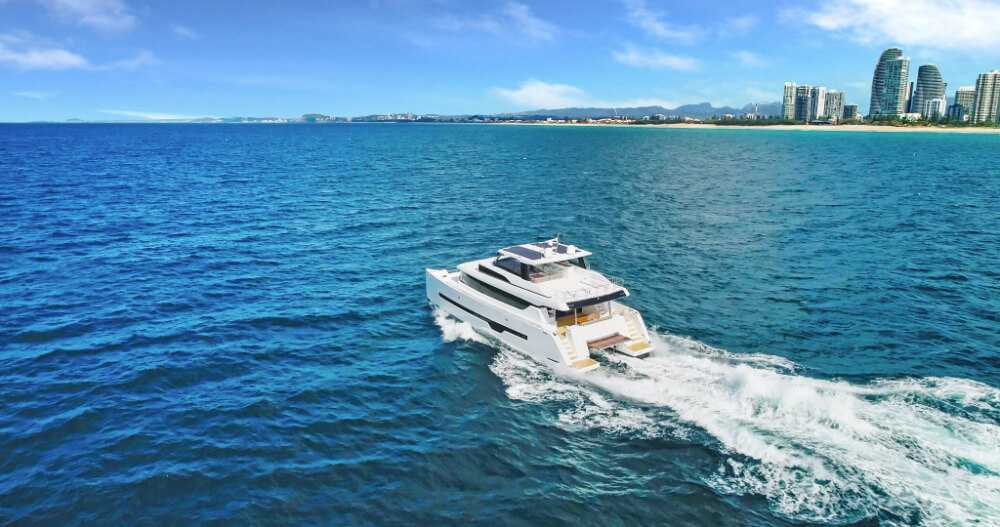
So, in fact the perceived problem is just that. It is only someone’s perception, and in reality, does not exist in boats where the appropriate design action has been taken. In a similar way the “wave piercing” displacement cat uses the larger central “hull” to prevent burying the low freeboard hulls and minimise slamming of the wing deck. All the above features also mitigate against bow steering, wave stuffing and broaching. But, when you are in the middle of a very wide expanse of ocean there can be no room for error.
WINGDECKS
The span of the wing deck is a direct reflection of the hull spacing. On a planing cat the hull spacing appears to have little effect on the performance. Conversely the spacing can have quite significant effects on the performance of a displacement power cat. If the space between the hulls is too small then there will be hull interaction and an increase in resistance.
So how close is too close? It depends on the length-to-beam ratio of the hulls and how fast the boat is going. The Malcolm Tennant design office designed two cats with identical hulls. One had an overall beam of 7m and the other, 5m. With the same horsepower the boat with the 5m beam was 2 knots slower. It should be obvious from all this that there is a much larger size/speed overlap between the planning and displacement hull form catamarans than occurs in the equivalent monohulled vessels.
With monohulls the displacement boat is on the low end of the speed scale and the planning boat on the high end. Admittedly there is an amorphous hybrid called a semi-displacement craft but generally speaking the planning and displacement vessels are quite distinct. Because it is not possible to separate the planning and displacement catamarans in the same way on the basis of top speed, it is just not possible to say which type is superior in a lot of conditions unless you define your requirements very carefully. If one of your requirements is to minimise fuel consumption, and for many owners this is the case, then there is ample evidence that a well-designed round-bilged displacement cat is hard to beat.
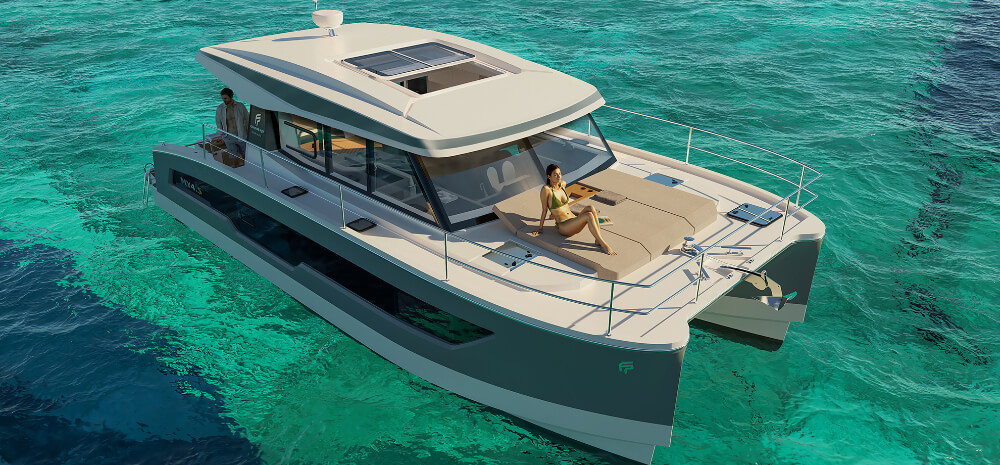
ACCOMMODATION SPACE
It is generally considered that a catamaran will always have more accommodation than a monohulled vessel but this is not necessarily so. If the beam of the catamaran is restricted to the same as that of a similar monohull, then the monohull may in fact have more interior space. Hard to believe? Then consider that essentially what has been done with the catamaran is cut a piece out of the centre line of the monohull. If the catamaran then has the same beam and length of the monohull then it does in fact now have less interior volume because we have cut that piece out and not replaced it by making the vessel wider.
So, restricting the overall beam of the catamaran to that of a monohull can impact quite severely on the accommodation.
YOUR CHOICE
So, is it possible to generalise in any way concerning which type of vessel should be your choice? It is very difficult to do this because often the choice of boat is influenced by emotional factors as much as rational ones. It probably depends mostly on where your priorities lie. If the styling is the dominant factor, and if you are looking for a vessel that has a profile of no greater height than a monohulled craft of the same size, then you are probably going to have to go with a planning cat with a very low tunnel height. You will have to accept that the wing will hit sooner in rough water and you will generally require more horsepower to drive it.
Conversely, if you want a high tunnel height and good rough water capability combined with economy and extended range, then you are going to have to live with the higher profile that accompanies these characteristics. If you are looking for lots of accommodation in a short boat then you will need a boat whose beam is going to make the use of a marina berth problematical.
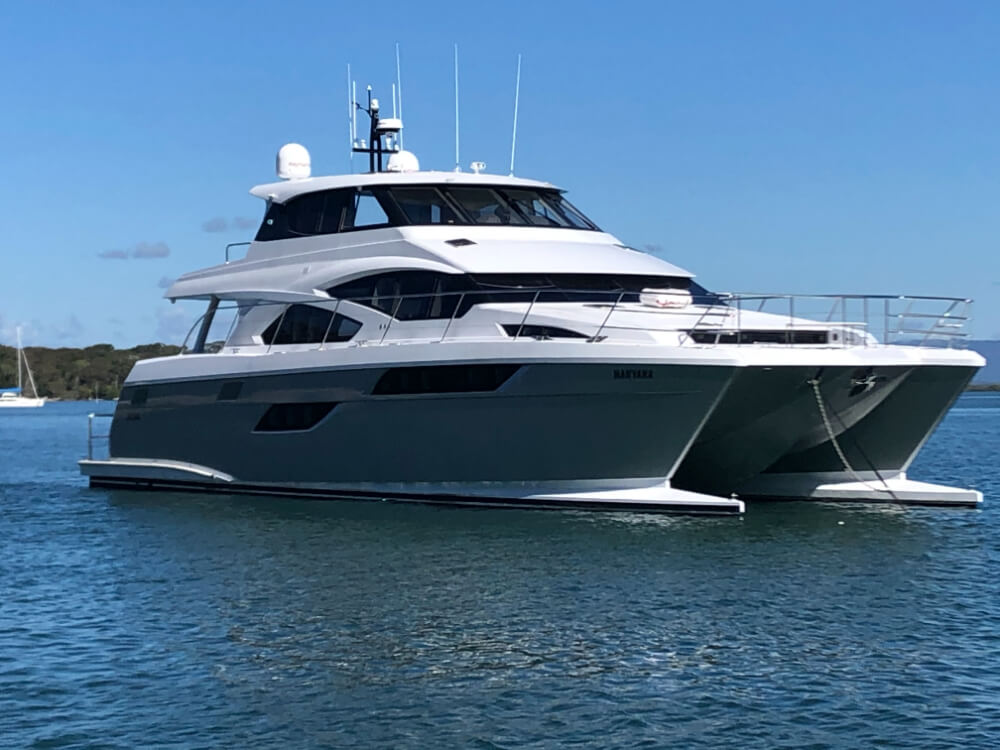
If easy engine access is your major requirement then perhaps you should be looking at monohulled craft because no catamaran (particularly displacement hull cats) has the wide-open engine rooms that can be found on some monohulled vessels. However, planning vessels will generally have wider hulls and will often have the engines located further aft than in a displacement boat, particularly if surface drives are being used. If fuel economy is the number one priority then a high-speed displacement cat (up to around 26 knots) can give this to you over a wide speed range, with a significant increase in cruising range for any given fuel capacity.
In addition, well-designed displacement cats have outstanding seakeeping, but they will usually have less accommodation space in the hulls than do planing cats. However, this will usually be offset to some extent by the fact that displacement cats tend to have greater overall beam than do planning ones. It should be mentioned that beamy displacement cats can be too stable with a very uncomfortable ‘snap’ roll in beam sea conditions.
An there is the question of power. The majority of power cats over 10m will have a pair of diesels, either through shafts or sterndrives. Smaller lighter power cats favour twin petrol outboards, but with the advent of high horsepower and high torque diesel outboard, there is a whole new power source available for larger power cats.
This is a very brief summary of what is a very complex topic. The possible permutations and combinations of the hull type, style, drive system and accommodations of a power catamaran are considerable – much greater than for monohulled vessels. But hopefully the article shows that there are some generalisations that can be made about the large number of different types and styles of catamaran, each of which will have a particular advantage or disadvantage depending on its intended purpose. Ultimately, it always comes down to horses for courses and, of course, your personal preference. Along with this must go the recognition that all boats are compromises and that you just cannot have a boat that will excel at everything.
| POWERCATS 9.5M -24M | ||||
| LOA BEAM TYPE | ||||
| AQUILA | ||||
| Aquila 32 Sport | 9.93m | 3.85m | Targa | |
| Aquila 36 Sport | 10.96m | 4.45m | Targa | |
| Aquila 44 | 13.44m | 6.56m | Open Flybridge | |
| Aquila 54 | 16.50m | 7.68m | Encl Flybridge | |
| Aquila 70 Luxury | 21.26m | 8,20m | Encl Flybridge | |
| ARROWCAT | ||||
| ArrowCat 320 | 9.50m | 3.05m | Sedan | |
| ArrowCat 420 Coupe | 12.73m | 4.50m | Sedan | |
| ArrowCat 420 Fly | 12.78m | 4.50m | Open Flybridge | |
| CARBON CATS – | ||||
| Carbon Cats 20 | 20.00m | 6.80m | Sport Sedan | |
| CATAMARANS INTERNATIONAL | ||||
| CI-360 Pacificat | 10.8m | 4.30m | Enclosed Flybridge | |
| CI-360 Express | 10.8m | 4.30m | Open Flybridge | |
| CI-5300 Flybridge | 16.0m | 5.70m | Enclosed Flybridge | |
| CI-5300 Express | 16.0m | 5.70m | Sedan Cruiser | |
| CI-6000 Flybridge | 18.50m | 5.70m | Enclosed Flybridge | |
| CI-6000 Express | 18.50m | 5.70m | Sedan Cruiser | |
| CI-6500 Flybridge | 20.0m | 6.50m | Enclosed Flybridge | |
| CI-6500 Express | 20.0m | 6.50m | Sedan Cruiser | |
| FOUNTAINE PAJOT | ||||
| MY4.S | 11.0m | 5.10m | Sedan Cruiser | |
| MY5 | 12.20m | 6.00m | Open Flybridge | |
| MY6 | 13.40m | 6.61m | Open Flybridge | |
| Power 67 | 19.69m | 9.84m | Open Flybridge | |
| HORIZON PC | ||||
| PC52 | 16.49m | 6.75m | Open Flybridge | |
| PC60 | 18.51m | 7.47m | Open Flybridge / Skylounge | |
| PC 65 | 20.23m | 7.47m | Open Flybridge / Skylounge | |
| PC74 | 22.49m | 8.63m | Open Flybridge | |
| HERLEY BOATS | ||||
| Herley 3400 | 10.20m | 4.70m | Sedan Cruiser | |
| Herley 6000 | 18.30m | 8.10m | Sedan Cruiser | |
| ICON CUSTOM BOATS | ||||
| R 356 | 10.60m | 3.50m | Open Flybridge | |
| R 431 | 12.67m | 5.00m | Open Flybridge | |
| R 544 | 17.25m | 5.97m | Enclosed Flybridge | |
| R 656 | 20.00m | 7.50m | Enclosed Flybridge | |
| ILIAD | ||||
| Iliad 50 | 15.51m | 7.35m | Open or Encl Flybridge | |
| Iliad 53.S | 16.30m | 7.60m | Sedan Cruiser | |
| Iliad 60 | 18.95m | 8.19m | Open or Encl Flybridge | |
| Iliad 70 | 21.08m | 9.15m | Open or Encl Flybridge | |
| Iliad 80 | 23.99m | 9.96m | Open or Encl Flybridge | |
| K2 MARINE | ||||
| Wright 46S | 15.00m | Sedan Cruiser | ||
| Wright 46FB | 15.00m | Flybridge | ||
| Wright 52S | 16.00m | Sedan Cruiser | ||
| Wright 52FB | 16.00m | Flybridge | ||
| LEOPARD | ||||
| 43 PC | 13.00m | 6.72m | Open Flybridge | |
| 53 PC | 15.40m | 7.64m | Open Flybridge | |
| LAGOON | ||||
| Sixty 7 | 20.15m | 10.00m | Open Flybridge | |
| Seventy 8 | 23.80m | 11.00m | Open Flybridge | |
| LONGREACH | ||||
| Longreach 44 | 13.45m | 6.50m | Open Flybridge | |
| Longreach 54 | 16.55m | 7.20m | Open Flybridge | |
| PROWLER | ||||
| Prowler 11.5 | 11.50m | 5.00m | Sedan Cruiser | |
| PROFAB | ||||
| Hill 12 | 12.00m | Sedan Cruiser | ||
| VOYAGER | ||||
| V1040 Explorer | 10.40m | 4.20m | Sedan Cruiser | |
| V1100 Discovery | 11.10m | 4.25m | Open Flybridge | |
| VOOXDOO YACHTS | ||||
| XF 50 | 15.25m | 5.30m | Sport Sedan | |
| XF 60 | 18.00m | 6.30m | Sport Sedan | |
| XF 66 | 20.00m | 7.00m | Sport Sedan | |
| XF 80 | 24.00m | 8.30m | Sport Sedan | |




